Camp Woody 70’s Year by Year 1975-
Introduction to Parts One and Two:
When I wrote the other articles in this series on Camp Woody, I wrote from the perspective
of a “camp kid” who first came to Woody as a kid of three, and finally grew old enough
to be a camper. But from 1970 to 1977, I was a staff member in various capacities,
and in 1978 I served on the camp board. It is not easy to write about myself as
a camp staff member, because I want to avoid patting myself on the back in any way.
I will limit my comments to what I learned from serving at camp, and how it felt
to be there working with the many wonderful volunteers who kept the place running. It’s
up to someone else to describe what it was like to be on the receiving end of the
ministry there during that time. So I will try to write down what it was like at
Camp Woody in the 70’s from the perspective of a full-
Below: Four photos from my square-
Camp Woody 70’s Year by Year
Part Two: A Photo Diary of 1975 to 1977
Written by Timothy Smith in 2006, Revised 2020
1975: A High Point of Fun and Friendship
As a kid who grew from “camp brat” to camper to staff member, I remember a few key seasons as being especially significant. The revival we experienced in the summer of 1971 was one such time. But for me, 1975 was a high point in friendship and fun. We really had a special time in the summer of 1975. The staff was as close as I had ever seen, and more new counselors became a part of the camp family. But for me something clicked that year, and not just because I got to know my future wife Debbie! There was more maturity in my experience, and I felt more comfortable leading the Bible teaching in the Senior High camp and leading the music.
Kelly and I had a great time leading singing, even though we no longer had anyone
else to form a group sound. We recorded our music several times that year, laying
down most of our solo songs in the chapel and most of our sing-
Perhaps I also loved the summer of 1975 because I had worked with several of the
staff before, and already had strong friendships with them. As had happened the
previous year, friendships were formed that have lasted the rest of my life. Larry
Le Doux was back, as was Bruce Adams, and the repeat service helped to form a stronger
bond for me. Larry’s intellect and humor kept my mind sharp. And Bruce’s emotional
and spiritual maturity helped to keep my own emotions in check. A new addition that
year was Cody Custer, who not only fit right in but came back to Kodiak for the next
two years. Cody’s energy and playfulness was a great contrast to the more sober-
On the ladies’ side of the staff, three marvelous and beautiful women came to help us (and probably helped to moderate the male gawkiness that we had in abundance). Kathy Arita and Diane Chestnut were sweet people, hard workers with a gentle spirit that ministered to campers and staff alike. The other new counselor, Diane’s best friend Debbie Sullens, was simply the most spectacular young woman I had ever met, with a kind, patient nature, and abundant good humor. She was quiet but not shy, with a mature competence in any situation, including the inevitable “camper chaos,” such as when a bunch of kids came down with the stomach flu. Before the end of the summer, I knew that Debbie was someone I wanted to know considerably better!
Unfortunately, 1975 was also the last year that the Bokos would be at Camp Woody. Their departure from the scene left a big hole in Camp Woody, but in the summer of 1975, none of us knew that was coming. Since I was growing more mature (by small stages, to be sure) I began to see how special the dedication of the Bokos and my parents and people like Beryl Torsen and Dee Dee Bailey really was. These were all wonderful examples of servanthood and dedication to the cause of Christ, committed to passing on the good news of Jesus to younger generations. What an example to follow!
1975 was a blast. There was a large percentage of returning campers that year, some of whom we had known for years. The campers benefited from seeing the returning staff again, but soon made deep friendships with the new counselors. Good weather, good camps, good company and a wonderful place to spend a summer! I was always aware of how wonderful it was to be on Woody Island at the camp all summer, but every now and then the “specialness” of it was almost overpowering. Even then I knew that I was having the best young adulthood anyone could hope to have.
We did weird things like bringing an abandoned FAA outhouse (replete with orange and white paint) back to camp just for the heck of it, and searching through every Quonset hut on Long Island. Even the challenging things like the “beef on tap” episode recounted in the 70’s Memories article, and the stomach flu outbreak in one of the camps could not blot out the satisfaction of that very successful season. For the previous three years I had moved my darkroom from Ouzinkie to Woody every spring, and I took photos of every thing that moved that summer! I made and gave away hundreds of photos (see four examples at the beginning of this article). Campers were always pleased to get photos that came from camp. I’m sure all was not sweetness and light–it hardly ever is—but so much about that summer was especially (for lack of a better word) fun.
The following season was to be one of the most difficult we had ever faced, but for a season the camp was an oasis of friendship, adventure, and spiritual growth on our road to adulthood. As always, I’m speaking from my own perspective, but 1975 for me was the ultimate balance of service and enjoyable surroundings, of spiritual growth amid youthful adventure.
A 1975 Photo Album:

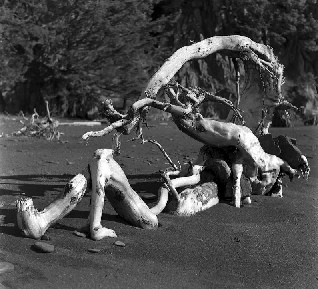



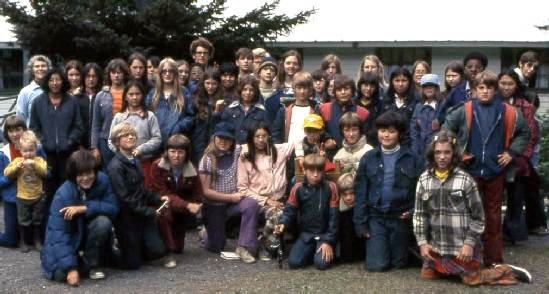
Top: Senior High camp, 1975 (Joe Ritchie photo). Bottom: Junior High camp (Cody Custer photo). So many wonderful people, and I wish I could name them all!










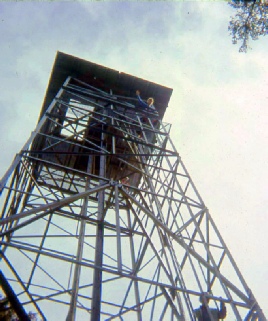








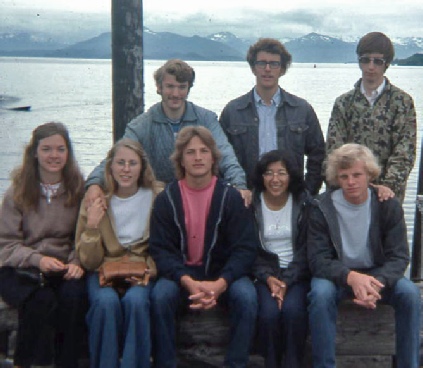












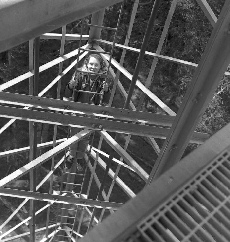























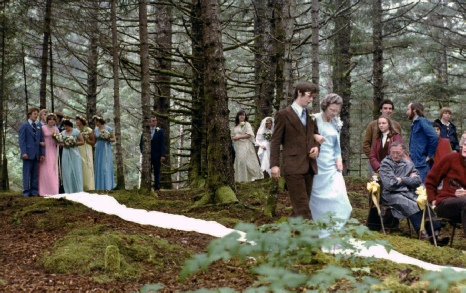

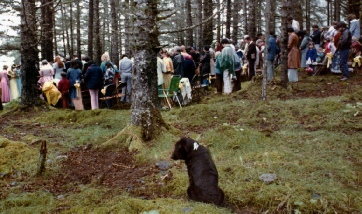










Top Left: Diane, Debbie, Janette, Oscar the dog, Kathy with Joe Ritchie in front. Top Right: A cabin group of high school boys gang up on Emil Norton, Jr. (Center right). Bottom Left: A cabin group of great boys. The one holding the trash can is Mat Freeman, behind him is Jon Le Doux, and the guy holding the cow skull is Jimmy Challiak. Bottom Right: Debbie sits on a picnic table surrounded by campers, while my brother Kelly sits in front.
Top: I love the concern on the campers’ faces for this injured seagull that Cody is holding! Middle Left: a lively beach volleyball game from a window in the main building, looking toward the chapel. Center Right: Debbie collects firewood on Sawmill Beach. Bottom: an outdoor concert by “Tim and Kelly.” We had no mic stands, and so a couple of sticks and cinder blocks had to work. The campers really loved to sing that summer!
An Excursion to Long Island to Explore Fort Tidball! Top Left: There were too many high school campers for the Evangel to make a single trip, so Bill Torsen helped with his Voyager, which dwarfs the Evangel at the Woody dock. Top Right: Cody Custer shot this photo of the Evangel unloading campers from the Voyager’s deck. Bottom: the campers enjoy a quick game of touch football before heading out to explore.
Top Left: The north coastal battery at Castle Bluff. Top Right: The south coastal battery, where I pose with a couple of campers (Debbie Sullens photo). Center Left: climbing the old radar tower is a shaky rite of passage (Debbie photo). Center Right: Debbie, Cody, Diane, and Joe pose atop the radar tower. Bottom Left: Margo and Oscar the dog explore a Quonset hut. Bottom Right: a “Field Layout” poster found in a partially collapsed Quonset. The poster is now at the Kodiak Military Museum.
After the last camp of the season, four guys and Oscar the dog spent a few nights camping and exploring on Long Island. Top Left: Kelly and Larry enjoy a campfire. Right: Oscar and Larry explore a searchlight and machine gun bunker on the south end. Bottom: we wore poor Oscar out! (An eagle landed on Larry’s back and then knocked over a cooking pot, stealing our bacon!)
Left: a fantastic summer staff: Rear L to R is Tim, Kelly, and Larry. Front L to R is Diane, Debbie, Cody, Kathy, and Bruce. Right: Debbie and Tim at the end of our first summer.
1976: The Summer of Challenges
Left: Marianne Boko and Cody Custer (pictured) work on a series of signposts on the trail to camp, featuring Bible verses. Gabie Boko poses in front of the finished sign, featuring John 14:6. Cody Custer photos
The Rebuild Challenge! Scenes of the dining hall and cabin one being drywalled. Right: in a moment of levity, Larry poses with a destroyed tape measure. We also accidentally left a hammer somewhere in the walls!
The most difficult summer I ever experienced at Camp Woody was the 1976 season. The
camp board had decided to upgrade the dining hall, kitchen and Cabin One (the downstairs
of the main camp building) by replacing the ancient Cellotex with new drywall and
paint. The camp schedule was adjusted to allow a few weeks for the remodeling job. Unfortunately,
as frequently happens in an all-
Of all the helpers and part-
Finally we got the walls back in reasonable shape, and a nice Lutheran guy came over for several days to mud them (he taught me how to do it). I honestly don’t remember who helped us paint (including sanding and painting the floors for the first time ever). When it was all finished, the place was sparkly and new, and we were reasonably proud of ourselves. I think most of our work is still in evidence. But the toll on all of us, emotionally and spiritually, was enormous. I began the camping season essentially exhausted.
It took awhile for the exhaustion to be replaced with the old fire and enthusiasm,
but eventually the joy of working with the campers replaced the frustration of construction
and deadlines. The photos that I took that summer show a bustling, happy place, with
lots of great goings-
There were some outstanding, happy times in that summer. One of the special memories
of 1976 includes going with Bruce Adams to a bunker on Long Island and singing into
a portable tape recorder. We carted my Gibson 12-
I greatly appreciated having Bruce there at Camp Woody for most of the summer, since he and I had gotten to be very close friends. He had been a counselor in 1974 and 1975 as well, and in the winter months had often provided me with a place to stay when my college closed down during holidays. 1976 was to be the last summer of his involvement at camp, but he was by then a lifelong friend. His “even keel” temperament was helpful in bringing me back to plumb on numerous occasions! Our paths still cross whenever we can arrange it, and he has helped me on many music projects since the early 1980’s. We stayed at his home in 1996 when Debbie and I first visited Kodiak with our family. Another cool thing that summer was that Travis North, counselor from 1969 to 1972, came back to Alaska to work at the Mission that summer. He brought his wife Carol, on her first trip to Kodiak. Travis was busy putting sheetrock in the buildings at the Mission that summer, or he would have helped us at Woody. But they broke free occasionally to come to camp and visit, and it was great to see him back at his old stomping grounds. And he took some wonderful slides, as usual!
That summer turned out to be good for music! I had scrounged a marginal old Concertone reel to reel machine somewhere in California the previous winter, and it allowed us to record fairly reliably in stereo. “If that thing’s not running at the right speed this time, I’ll blow it up!” can be heard between a couple of songs. Kelly and I put together a makeshift recording studio in the dining hall (one snatch of talking between takes has us asking Mom not to start sweeping!) and recorded several songs that I had written. We also recorded a complete set of our camp songs with the dining hall full of enthusiastic Junior High kids. Kelly and I had now worked together for four straight summers, and the list of songs we had accumulated (starting with John Hicks’ 1971 originals) was impressive. Tom Stipe’s “Stagecoach” and the theme from Johnny Cash’s “Gospel Road” were among the campers’ favorites. With music so much a part of our lives at camp, it’s surprising we never invested in good equipment. On the other hand, it was never about performance, but about putting the song and its meaning front and center. The recordings never captured the essence of camp music, and besides, recording wasn’t what we were there for. But we sure had terrific songs!
We also made some cool trips in the Evangel that summer, taking the staff between camps to visit our home in the village of Ouzinkie, and taking the older campers to Long Island. It was wonderful to have the use of that old boat! But Dad had recently gotten word of his impending retirement (not a voluntary move on his part) and he had to spend some of his time that summer in Ouzinkie, where he was arranging for other employment and for a possible move from the village. Thankfully, that move away never materialized, and Dad was able to spend the rest of his life in Ouzinkie among the people he loved. He found work running the village water system and power plant, and had the contract to deliver freight from the post office to the airstrip for many years. But all these changes meant that he was not with us as much as in previous years. Mom Joyce was able to spend the summer with us, even when Dad was away. We certainly felt his absence, no one more than Mom. That summer made me realize the great investment of time that folks like Norman and Joyce Smith and the Bokos had made in Camp Woody. This was the first summer without the Bokos, and that also added to the difficulties we experienced.
But I need to mention another, much happier event from that summer. Debbie Sullens
and I had been getting steadily more interested in each other since the previous
summer when she had been a counselor. We had been writing to each other all summer. Naturally,
I was delighted when she decided to come up to camp to visit us again. She arrived
late in the camp season, and stayed until mid-
The summer of 1976 ended with yet another successful season. Considering how it had started, that was surely a “God thing.” It had started out rough, but there was still that unmistakable blessing of spending a summer with rambunctious kids on a gorgeous Alaskan island. I was privileged to be working with my brother and parents, and with lifelong friends like Larry and Bruce as well. We’d had a hand in upgrading the facilities, we’d played a lot of great music and hiked to a lot of beautiful places. But our goal, as always, was to see young people drawn closer to God. That is what happened. And that is what Camp Woody is all about.
A Scrapbook of 1976 Photos:
These Photos Would Look No Different in Color! Left: Some camps had a little more
rain in 1976 than in some years, but we had campfires and hikes and activities anyway. Right:
kids create a makeshift teeter-
Our great staff ladies, 1976: Michelle, Linda and Sue. They were hard working, encouraging and cheerful, in a year that had more than its share of challenges and transitions. The guy staff was Larry, Bruce, and me, in our third year together. These women undoubtedly went through more difficulties than they should, due to the pressures the camp faced that year.
Top: Larry patiently cooks a doughboy over a very smoky fire that seems to be bothering some of the campers! The smoke indicates wet wood, the bane of our existence on those rainy days! (Travis North photo) Bottom: Michelle surrounded by campers is one of my favorite photos from 1976.
Camp Visits Long Island and Fort Tidball in 1976. Top Left: Rev. Norman Smith brings
the Evangel right up to the shore in Cook Bay. Top Right: Kelly helps unload campers
using the camp’s new Boston Whaler skiff. Left: This mid-
The old radar tower on Castle Bluff always caught everyone’s imagination. Left: a view up the ladder from the base. Middle: a view down the center freight elevator shaft from the top. Right: Debbie Sullens nears the top in 1975.
There were lots of “parts missing” on that tower, and it was not very safe. It was a shaky, arduous climb, and there were bragging rights for folks who made it to the top. Below: The 1976 portrait from the top. L to R: Felicia, Veronica, Michelle, Linda. Seated: Vicki
Top Left: the entrance to a bomb shelter on Deer Point, looking down from the earthen
berm built up in front of the entrance. Top Right: the open doorway into the shelter,
a huge metal can in the hillside. Bottom: campers explore the south coastal battery
on Castle Bluff. The guns were actually maintained until the mid-
Left: The Deer Point ammunition bunker in 1969, one of three on Long Island. In 1976,
Bruce, I and my 12-
Right: The great 1976 staff. Back row L-
Below: A lovely slide by Debbie of the Evangel and its new Whaler skiff heading to Kodiak.
Smith Family Changes:
Top: In July, 1976, Debbie Sullens came back to Camp Woody for a visit, and in mid-

1977: An Ending and a Beginning
My last summer at camp is a bit of a blur. There is more of a bittersweet emotional
memory of that year, bitter because I sensed it was to be my last season there, and
sweet because the glorious chaos of a thriving youth camp was all around me. I knew
it was bound to be my last summer there, because I was now a year out of college,
I had been working all winter in Kodiak, and I was about to get married at the end
of the camp season. It was, nevertheless, one of the more enjoyable summers I spent
at Camp Woody, and it was especially smooth after the multiple struggles of the 1976
season. I was a bit distracted I’m sure with the prospect of getting married, and
I hope I did a good job that summer. But it was a sweet and pleasant camp season,
and I tried to savor every minute. I had been a full-
The original stalwarts of past years were slowly drifting away. Bruce and Cody were in Kodiak working, and were not on staff that summer (although they visited when they could). The Bokos were long gone. And worst of all, my Dad, Rev. Norman Smith, was struggling through his first summer in forced “retirement,” weighing his options (including taking a pastorate in some small church in the states) and working for the village of Ouzinkie. Dad was able to work his hours so that he was with us for several days at a time, and he used the Evangel to transport kids to camp all summer, but he wasn’t around on a daily basis. Mom Joyce served as camp manager and nurse, but it was different and strange; the Smith family’s involvement in the camp they helped to build was entering its last chapter.
There were good people on the counseling staff that year, including Jeannette from
California and Lorie who later moved to Kodiak. But I didn’t feel as though I got
to know anyone as well as I could have. We still had our share of adventures. During
Senior High camp, we got to make our annual trek to Long Island. I roped a bunch
of kids into going down to that previously-
Then between camps, Dad took the whole staff in the Evangel to old Afognak village,
abandoned after the Tidal Wave. Dad tried to find film for me in Kodiak, but no one
had any more rolls of 120 Verichrome (or 120 anything), so I went on what should
have been a marvelous photo safari with nothing but my eyes and brain. We were very
respectful of the old buildings, but I did go into the attic of the vacant Russian
Orthodox Church and viewed the unique log and wood-
The journey across Marmot Bay and back to Woody was to be the last great voyage of the Evangel. It made a few more trips to Ouzinkie before it was unofficially retired in the late 1970’s, victim of the fact that Norman Smith was now too busy working to use it or to pay the insurance needed to haul passengers. The boat was also expensive to run and maintain, and my parents were in the process of buying Baker Cottage in Ouzinkie from their former employers, and so the boat lost out. The camp board, struggling to maintain their own ragtag collection of buildings on Woody Island, could never have taken on the expense of maintaining and using the Evangel themselves, if they could have found someone to run it. As strange as it may seem to me, who lived and traveled aboard it part of every summer from 1953 to 1964, the Evangel was only a tool, and my parents, who ran it for years, were now stuck with a limited budget and a struggle to make ends meet, forced out of the Camp Woody universe by their change in employment.
The Evangel as a working, usable vessel met a rather un-
Snapshots of 1977:
Left: An abandoned lumber camp on Afognak Island in 1974. The new one is out of frame to the right. Notice the Evangel at anchor and a float plane taking off beside it. This photo has to stand in for our wonderful voyage to old Afognak village with the staff aboard the Evangel in 1977, because nobody in Kodiak had any film to fit my camera! Memories will have to do.
Left: Joyce Smith ready to board the Evangel, summer of 1977. Right:The Evangel is ready to load passengers in its last season, 1977. Photos by Don Wells
Top: A group of hikers rest at the Arch before going on around to Sawmill Beach for lunch, summer of 1977 (one of the few photos I took that summer). Left: A poster made by a combined cabin group led by Pam (the girls) and Tim (the boys). Mat Freeman was in my cabin and is largely responsible for the multitude of puns based on “Pam, Tim, and Gang.” Favorite dinosaur? Pterodactyl. Favorite animal? Ptortoise. Favorite flowers? Ptunias. Favorite food? Ptato chips. And so on. What a blast we had that summer!
Top: I lead a bunch of campers in a sing in the BOQ (boys’ dorm) next to a fireplace donated by Darrell Chaffin. Bottom: a composite photo of Kelly (left) and Tim playing music at Camp Woody in 1977. We seem to be just relaxing here. By this time, Kelly and I had led music together at camp for five years. In 2000, Kelly played and sang on several tracks of my “Stone Table String Band” CD, available at this site. Don Wells supplied these photos.
For Lots of Sound Samples and Stories About Our Music, Click Below:
Left: Mat Freeman waves the flag. Hopefully that was his shirt? Right: On the same beach hike, I became the “Counselor from the Black Lagoon” thanks to a hat of seaweed. These random shots speak to a fine time being had by all!
Top Left: L to R: Burl, Georgette, Maid of Honor Diane Chestnut, Rev. Norman Smith, minister and Father of the Groom, Larry Le Doux, Best Man, and a little corner of Kelly. Top Right: Lori Weisser (at the pump organ) and the bridal party look on as my brother Kelly plays my camp “flower” guitar and sings Paul Stookey’s “Wedding Song.” Botton Right: Oscar, the camp dog, with his flower collar, seems to bow his head during the prayer. (Top two photos are from Marian Paden. The rest are from our wedding book by Roger Page)
A Wedding at Woody: Debbie and Tim, 8/19/77
At the end of the camping season, my own great adventure began, when my fiancé Debbie came to town with her parents, and other friends such as Carol Chapman (1974) and Diane Chestnut (1975) began to arrive. The Smith family was ending their careers at camp with a flourish: we were planning the first and only wedding at Camp Woody. After the last campers had gone, the dining hall was transformed into a flower shop and bakery, as various friends from Kodiak assembled bouquets and wedding cake, and prepared the reception menu. When the day finally arrived, what a strange looking group of men accompanied me down the trail at Tanignak Park: Larry, my best man, was dressed in a stunning dark brown suit. Bruce and Cody and my brother Kelly were also dressed to the nines. Quite a change from the “Frog, Toad, Wart and Hair” of 1975! Lori Weisser, frequent camper and staff member, played the pump organ so Mom could be the Mother of the Groom. Debbie’s bridesmaids were quite a bit more color coordinated than my guys. Janet and Georgette from California, and Lorie from that summer’s counselor staff were bridesmaids, and Diane Chestnut, Debbie’s best friend, who had served at Woody in the 1975 season, was her Maid of Honor.
A white cloth runner was stretched diagonally from the Inspiration Point trail through
the trees to the wedding site, and chairs and benches had been scrounged from the
chapel and cabins. My meager PA system and microphones were set up thanks to a couple
of long extension cords that stretched to the old light plant shed. It was a gray
day, and in fact we nearly canceled (to regroup at the Community Baptist Church)
but at the last minute the rain stopped. You could still hear drops of water hitting
the microphones from time to time. That and the fact that Larry lost my ring in
the moss for a few minutes (to tell me about much later) made it a typical Woody
adventure. But the slightly foggy air gave those tall trees in Tanignak Park a cathedral-
Debbie appeared, looking absolutely glorious against the mossy forest in her lovely white gown, walking down the runner with her dad Burl. My Dad in his old black suit began the ceremony. I remember that I tried to sing a song at one point (I don’t recommend it at your own wedding). Kelly did much better singing for us! Then Dad spoke in his understated, simple way, that deep, calm voice echoing through the trees. We said our vows and the ceremony ended, and we walked up the white runner to the road. Enough people to fill the dining hall had come from town to share our moment, and soon we were seated at the benches (in suits and gowns and everything) to eat a fabulous spread of local delicacies. Then Debbie went up to the ramp that went to cabin 4 and 5 and threw her bouquet, and we were off on the Evangel to catch our plane. I don’t think I ever got to take another trip on the Evangel again, and from what I’m told, ours was the first wedding at Camp Woody. It was an amazing day, and the Smith family concluded their long run as camp staff with a grand celebration!
Some Photos of Our Day:
Left: Shirley Le Doux (Larry’s mom), Mother of the Bride, Edith Sullens, and Mother of the Groom, Joyce Smith gather under the trees, ready to get walked in. If you look closely, you can see water droplets on the spruce boughs—just another Kodiak day! Right: Larry walks Edith to her seat, while the wedding party and Burl Sullens, Father of the Bride (behind a small tree) wait on the upper trail. (Left photo is from Marian Paden)

Right: We leave the service and go to the dining hall reception, all smiles. That day our wedding song could have been, “Wait a minute, it stopped raining…” We’re followed by Diane and Larry, Georgette, and Kelly. Dad stands watching between the trees.
Left: Debbie and I examine all the wonderful dishes (I’m bending over a tray of lovely
salmon perok), joined by Lorie and Georgette. On the other side of the table, groomsmen
Cody and Bruce have changed back into camp clothes in record time! At the end of
the table, Edith, my new Mother-
An Epilogue of Sorts
It’s been over four decades now since the summer of 1977. The following summer I was working full time, trying to get enough money so that Debbie and I could move to California to find better work. I had tried many avenues of employment, and found none that were good career moves. (Ironically, I had done a couple of years of substitute teaching by then, and just knew that teaching wasn’t for me. Twelve years later I joined the staff of Montclair High School as a teacher, and retired in 2018 after 29 years there!) I got over to camp only once or twice in the summer of 1978, but I served on the camp board, and did what I could. I was pretty sure that I would never get to serve at Woody again. Thankfully, that proved not to be the case.
I got to visit several times in the 1990’s, including helping with music and serving
as camp chaplain in 1998. Then in 2006, I not only was able to help with music and
be a chaplain again, but was the director of Camp Woody’s Fiftieth reunion! The following
year, I helped with music and served as chaplain, but out of their desperate need
was asked to be a counselor for a group of rambunctious high school guys. We almost
burned out little cabin on the hill down, and naturally every last one of those boys
had toxic socks! Finally, in 2012, I got to return one more time to help dedicate
the newly-
Above: a lovely sunset sky over Mirror Lagoon, looking across Chiniak Bay towards
Barometer Mountain, at about 10:30 PM in early July, 1976 (Travis North photo). The
photo illustrates the never-
To access more camp articles or return “home,” click on the links below:
To Find Out More About Tanignak.com, Click HERE
To Visit My “About Me” Page, Click HERE
Information from this site can be used for non-